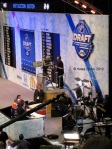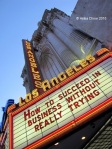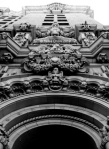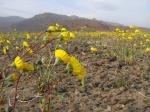
On Thursday, our Canadian friends Alison and Jeremy drove from Yosemite to San Francisco for dinner with us at the Ferry Building’s MarketBar. They are repatriating to Canada after living in Santiago, Chile for seven years. To ease the transition, they are currently taking a 12 week road trip through the Americas with their sons William (almost 11), Jackson (newly nine), and Lucas (four).
Dinner was messy and fun. We bonded over our respective experiences as ex-pats and squeezed nine years of stories into the time it took to share cocktails, oysters, pizza, and Pork Pork Pork. During the meal, Jackson drew the animal kingdom on a dry-erase board and the paper tablecloth. I really liked his dry-erase doodle of a blue dinosaur. The boys made countless trips to the washroom. They had appointed me to be their pee buddy, so I raced with them to and from the toilets. The boys were full of energy and seemed eager to test the plumbing and hand dryers. As they had started their day at a campsite, their fascination with creature comforts was understandable.
After dinner, we decided to go outside for the golden hour. As we left our table, I reminded Scott to pick up his bag, which he did. Once outside, we walked toward the water. I set up my tripod and we posed for this group shot in front of the Bay Bridge. Robertson Davies wrote that “a portrait is among other things, a statement of opinion by the artist, as well as a likeness”. I love how this photo captures essential qualities I see in William, Jackson, and Lucas. William is good-natured and has Alison’s confidence. Jackson has Jeremy’s calm and happy-go-lucky spirit. Lucas is a lover and a fighter in a charming pint-sized package. As we took the photo, several people milled about nearby – including a shabby-looking man on a bicycle. Scott, an avid cyclist, noticed that the man’s black Surly bicycle had a “Read a Fucking Book” sticker on it. Rather than linger among shady characters, we wandered across the pavement to the Ferry Building in search of ice cream. Along the way, Scott and the boys climbed all over Mohandas K. Gandhi, the statue of Mahatma Gandhi that greets people as they walk from the pier to the Ferry Building.
As we entered the Ferry Building, Scott realized that he no longer had his bag with him. He ran back to the pier and returned empty handed. Fortunately, Scott had his personal phone in his pocket. He used the “Find My iPhone” app to track the location of his work phone, which had been inside his bag. His work phone was already half a mile away. The thief was likely the man on the bicycle! Scott was afraid that the thief would soon disable location tracking on his work phone. He decided to run after the thief. Jeremy, who runs marathons for fun, was up for the chase. They sprinted away before Alison or I could reason with them. William wondered if Scott would get in trouble for losing his work phone. Alison assured him that Scott would likely be given another work phone without too much fuss. William asked me if I thought the thief would hand over the bag to Scott. I told him I didn’t know. As Scott and Jeremy unleashed their inner vigilantes, Alison and I took the boys to Humphry Slocombe for ice cream. To the boys’ delight, we had candid discussions about the effects of lactose intolerance and food poisoning. As I ate my flower power sorbet, I had visions of Scott and Jeremy getting shanked in the Tenderloin. I hoped our evening would end without a trip to the ER. I kept my morbid thoughts to myself. To her credit, Alison did not betray any anxiety until we finished our desserts – when I couldn’t reach Scott on his personal phone. I quickly dialed his missing work phone. Alison and I were both amazed and relieved when Scott answered right away.
Scott and Jeremy had caught up to the thief at an intersection. Scott recognized the bike and noticed his bag sitting on the bike’s handlebars, so he asked the thief for his bag. Jeremy wedged his foot behind the bike’s rear tire to prevent the thief from escaping as Scott reclaimed his bag. It was empty. Scott then asked the thief for each item that was in the bag before it was stolen: work phone; wallet; $100 cash; credit cards; government lab ID; earbuds; phone charger; FedEx receipt; gum… For each item, the thief rummaged through his pockets anew. Scott asked the thief repeatedly why he had stolen the bag. The thief denied stealing the bag. He claimed that he had found the bag with its contents strewn about a curb, and that he was planning on putting the bag in a mailbox. Scott considered calling the police and decided against it. He thanked the thief (!) and then walked away with Jeremy.
When Scott and Jeremy returned to the Ferry Building, they were all smiles and fist bumps. To catch the thief, they had sprinted 10 city blocks – stopping only to call the police (who claimed they couldn’t help without a suspect to identify) and to summon (then cancel) an Uber. To their dismay, the missing phone’s location disappeared and then reappeared on the app map as they ran. I asked Jeremy if he felt “young and alive” after the chase. He grinned, likened the caper to a sightseeing tour, and proposed that he and Scott run a marathon together. William exclaimed that he knew the man on the bicycle was trouble – he had noticed him while we were taking our group shot. I laughed when Alison voluntold Jeremy to pick up Lucas from the floor since Jeremy was feeling so young and alive; Lucas was having a meltdown between Alison’s ankles. Jeremy called an Uber. Within minutes, it was time for everyone to hug good-bye. Scott and I took BART home. I washed Scott’s bag in hot soapy water. He resolved to stop carrying a bag.









































































